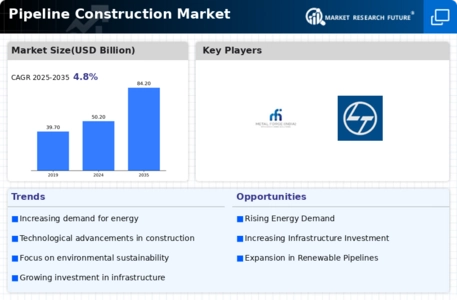By Region, the Pipeline Construction market is segmented into North America, South America, Europe, Asia Pacific, and Middle East and Africa. The Asia Pacific Pipeline Construction market held the highest market share in 2022 and is expected to exhibit a significant CAGR growth during the forecast period. The Asia Pacific pipeline industry has witnessed significant growth in recent years, driven by the expanding oil and gas industry, rising energy demand, infrastructure development, LNG infrastructure development, cross-border pipelines, renewable energy expansion, urbanization, and government initiatives, among many factors.
The Asia-Pacific region has vast reserves of oil and natural gas, including offshore fields, shale gas resources, and emerging exploration areas. The development and production of these resources require the construction of pipelines to transport them from production sites to refineries, processing plants, and distribution networks. The growing oil and gas industry drives the demand for oil and gas pipeline construction in the Asia Pacific region. Pipeline contractor and stakeholders are actively involved in meeting the region's energy transportation needs and contributing to its economic growth.
North America Pipeline Construction market is expected to grow at the fastest rate during the forecast period. The North America pipeline industry has been experiencing exponential growth due to the factors such as shale gas and oil production, expanding energy infrastructure, crude oil and natural gas exports, energy security goals, cross-border pipelines, regulatory frameworks, infrastructure upgrades, technological advancements, and environmental considerations. The advent of shale gas and oil production in North America, particularly in the United States, has driven the demand for pipeline excavation and construction.
Shale gas and oil reserves, such as the Marcellus and Permian basins, require pipelines to transport the extracted resources from production sites to refineries and distribution centers.
Figure 2: Pipeline Construction Market Size By Region 2022 & 2032 (USD Billion)

Source: Secondary Research, Primary Research, Market Research Future Database, and Analyst Review
Europe has a well-developed natural gas infrastructure, with an extensive network of pipelines that transport natural gas across the continent. The construction of pipelines is crucial for connecting natural gas production sites, import terminals, storage facilities, and distribution networks, ensuring a reliable and secure supply of natural gas to European countries. Europe is actively working to diversify its gas supplies to reduce dependency on a single source or route.
This has led to the construction of new pipelines and interconnections, such as the Southern Gas Corridor and Balticconnector, enabling the transportation of natural gas from new suppliers and facilitating gas trade among European countries.
South America has a growing natural gas sector, with an increasing demand for natural gas as a cleaner energy source. The construction of pipelines is essential for transporting natural gas from production sites to consumption centers, power plants, and industrial facilities. Countries like Argentina, Brazil, and Bolivia have invested in pipeline infrastructure to meet the rising demand for natural gas. South America is home to significant oil reserves and production. Pipelines play a crucial role in transporting crude oil from production areas to refineries, export terminals, and domestic markets.
Countries like Brazil, Colombia, and Venezuela have extensive pipeline networks for oil transportation.
The Middle East is home to abundant oil and gas reserves, making it a major player in the global energy market. The construction of pipelines is crucial for transporting crude oil, natural gas, and petroleum products from production sites to refineries, export terminals, and domestic consumption centers. Major pipeline industry projects in the region include the Trans-Arabian Pipeline (Tapline) and the East-West Pipeline in Saudi Arabia. Africa is rich in natural resources, including oil, gas, and minerals. Pipelines are crucial for transporting these resources from production areas to refineries, export terminals, and domestic markets.
Major pipeline industry projects in Africa include the West African Gas Pipeline (WAGP) and the Chad-Cameroon Pipeline.













